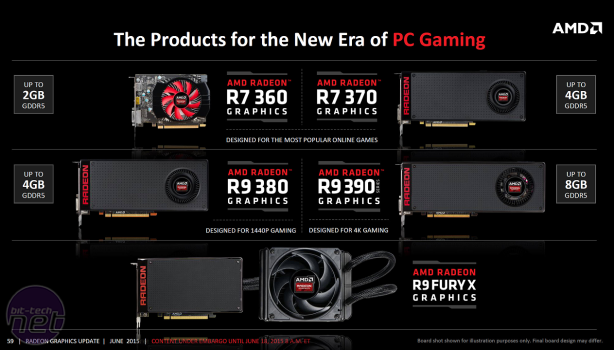
AMD's new Radeon R9 300 Series of high-end desktop graphics cards is notably more streamlined than the previous generation. The R9 200 Series featured six GPUs - the R9 295X2, R9 290X, R9 290, R9 280X, R9 285 and R9 280. The R9 300 family has half the number of GPUs with the R9 390X, R9 390 and R9 380 which are based on revised iterations of the R9 290X, R9 290 and R9 285, respectively.
AMD declines to call the R9 300 family rebrands, however, but they are mostly identical to their predecessors in physical terms yet do feature a variety of small tweaks. AMD has deployed ASIC and microcode enhancements, designed to improve power efficiency, larger default video memory capacities and higher stock memory speeds aided by the use of faster SK hynix memory chips. Four more new Fiji-based graphics cards will complete AMD's current generation of GPUs - the R9 Fury X2, R9 Fury X, R9 Fury and R9 Nano which are, arguably, part of the new R9 300 family even if not bound by the same naming strategy.
Sapphire Technology has prepared a full range of new R9 300 Series GPUs for AMD's R9 300 launch, so we will be looking at its R9 390X, R9 390 and R9 380 models. Sapphire's latest R9 300 graphics cards are a mixture of existing and new technologies with the Sapphire R9 390X sporting the long-standing Tri-X cooling solution while a new Nitro Series has been developed for the Sapphire R9 390 and R9 380, as well as the R7 370, which deliver an evolution of the Dual-X and Tri-X cooling solutions.
The Nitro Series from Sapphire is designed specifically with PC Gamers in mind and makes some calculated trade-offs to bring a more affordable price point without unnecessary features. The Nitro Series uses a consistent black-and-grey colour scheme and a mixture of dual- or triple-fan coolers depending on the heat output of the GPU. All Nitro Series graphics cards feature dual-ball-bearing fans and Intelligent Fan Control (IFC) II which allows fans to switch off during light loads while all PCBs are fitted with Black Diamond Chokes and 16,000-hour-rated capacitors for enhanced reliability.
A cost-saving measure has been deployed by choosing to not add a backplate to Nitro Series products but Sapphire claims the design decision to fix the fan shroud to the PCB provides enough rigidity that a backplate isn't needed. Clock speeds across the Nitro Series are fairly conservative, mind, with Sapphire choosing to add no more than a 15MHz overclock on any of its Nitro models. Higher clock speeds and more advanced overclocking features are likely reserved for the company's Vapor-X product line which has yet to be updated with R9 300. Interestingly, the Sapphire R9 390X Tri-X seems identical to the Nitro Series except it sports a different orange-and-black colour scheme.
Sapphire R9 380 Nitro 4GB
Manufacturer: Sapphire Technology
UK price (as reviewed): Approx. £180 (inc VAT)
US price (as reviewed): MSRP $220 (ex Tax)
Click to enlarge
The first graphics card of the Sapphire trio is the R9 380 Nitro 4GB graphics card coming to market for £180 here in the UK. Sapphire keeps the R9 380 with stock-clocked 5,800MHz memory while adding 15MHz to the reference clock speed giving a final 985MHz frequency.
Click to enlarge
A pair of large, 100mm fans and shroud using a black-and-grey colour scheme provide the primary cooling for the R9 380 Nitro's heatsink. The profile of the design is two PCI slots and the length of the graphics card measures in at 237mm, or 9.33 inches.
Click to enlarge
Power is supplied through a duo of 6pin PCIe connectors and Sapphire rates this GPU for a 225W TDP by sum of its power inputs - 75W from the bus and 2 x 75W from the 6pin PCIe connectors. AMD rates the reference R9 380 board for a 190-watt TDP. I/O options are flexible with dual DVI, a single HDMI and a DisplayPort.
Click to enlarge

MSI MPG Velox 100R Chassis Review
October 14 2021 | 15:04


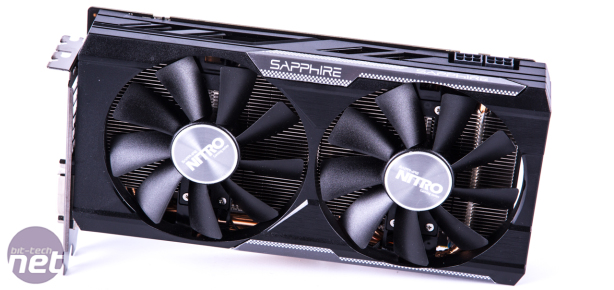
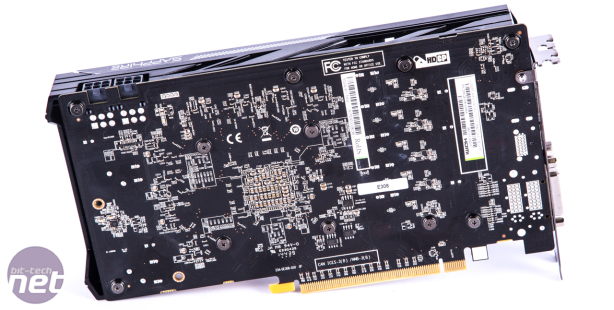
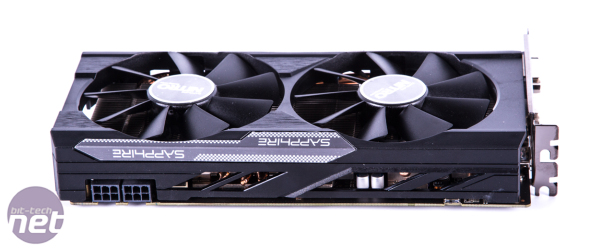
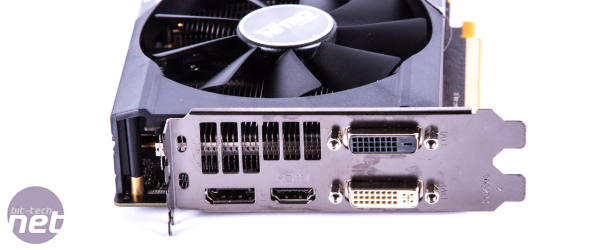







Want to comment? Please log in.